The Arctic is warming faster than anywhere else on Earth. Ice and snow are melting, and Arctic sea ice is thinning and retreating. This means that algae living on the bottom of the sea ice are getting more sunlight, leading to an annual summer bloom once there is enough light. Erebus, located on Antarctica’s Ross Island (separated from the mainland by McMurdo Sound), is the southernmost active volcano on Earth; the second-tallest on the sixth continent, at 3,794 metres.
Antarctica has increasingly attracted the attention of the scientific world in recent years. Various geological and even cosmic phenomena are observed here, which are important for understanding the planet and the Universe. In addition, vigorous volcanic activity continues on the sixth continent. It is estimated that there are 138 volcanoes in the territory of West Antarctica (one of the two main regions, the other being East Antarctica). Most of them are dormant, but about ten are currently in an active state; one of them is the unique Erebus: constant activity has been observed since 1972.
Erebus, located on Ross Island (separated from the mainland by McMurdo Sound), is the southernmost active volcano on Earth; the second highest on the sixth continent, at 3,794 meters. Erebus is located at the intersection of faults in the earth’s crust, which is why it is one of the most active geological formations on the planet. The faults periodically emit powerful emissions of deep gases, including hydrogen and methane, which, reaching the stratosphere, destroy ozone. Recent research by scientists has revealed that these jets of emissions contain gold crystals no larger than 20 micrometers.
The wind carries gold dust over huge distances. Its traces are found in the atmospheric air at a distance of up to 1,000 km from the island. During the day, the volcano erupts about 80 grams of gold, the cost of such a volume is about 6,000 dollars, reported the publication PLANET TODAY.
The Arctic is warming faster than anywhere else on Earth. Ice and snow are melting, and Arctic sea ice is thinning and retreating. This means that algae living on the bottom of the sea ice are getting more sunlight, leading to an annual summer bloom once there is enough light. Using years of CryoSat satellite data on sea ice thickness, scientists have been able to map the light reaching these algae.
The results show that since the 1980s, large swaths of Arctic ice may bloom a month earlier as the ice and snow cover thins due to climate change. The Arctic is at the epicentre of climate change, warming four times faster than anywhere else on Earth.
The Arctic Ocean has already undergone dramatic changes. Sea ice, which once covered vast expanses of ocean year-round, is now seasonal, melting and disappearing from large areas during the summer months. Much of the remaining ice is thinning, and snow cover is decreasing.
Rapid warming of the Arctic is affecting marine ecosystems, and not just polar bears and walruses.
“As the ice and snow become thinner, more light penetrates the underside of the sea ice,” said Julienne Strove of the University of Manitoba and the University of Colorado. “This changing light regime can impact the entire marine ecosystem, starting with the algae.”
On the underside of the ice, the lawn of algae expands each year. Just as open-water phytoplankton expands to cover vast expanses of ocean visible from space, ice-bound algae bloom over vast areas and support a complex food web.
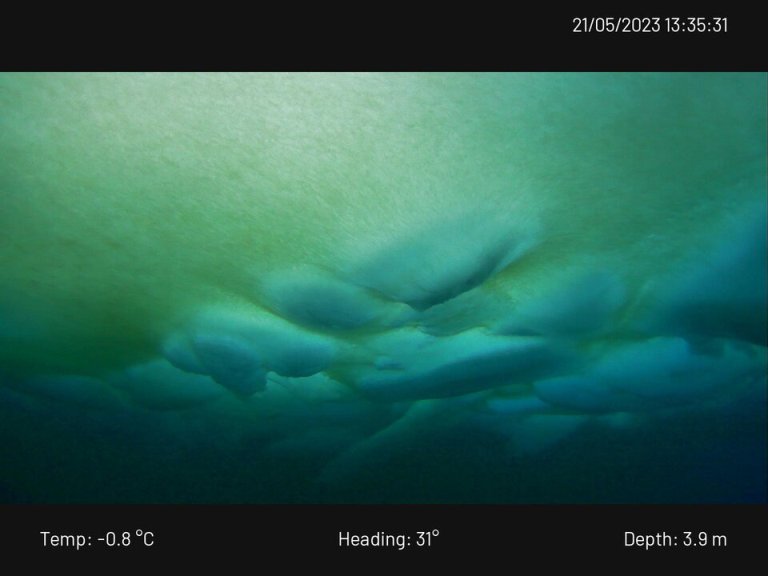
Ice algae growth
As the algae bloom, they are eaten by zooplankton from below, which then serve as food for a variety of animals, including fish, which then serve as food for seals, and then polar bears.
We still have a lot to learn about how climate change will affect this ecosystem, so algae, the main producers in the ecosystem, are a great starting point.
Mapping this object from space proved to be a challenging task.
“Unlike the open ocean, we can’t see algae inside sea ice from space,” says Carly Campbell of the University of Tromsø. “What we can do is start by assessing the availability of light. The light that ice algae collect to create organic compounds through photosynthesis is a major determinant of marine productivity. If we can map the light reaching the algae, we can get an idea of when and how intensely they might bloom.”
To understand this, you need to know the thickness of the ice and the amount of snow on it. Thicker ice and snow means less light can reach the algae underneath the ice.
That’s where CryoSat comes in. Using data from Copernicus Sentinel-3 and NASA ICESat-2, scientists estimated the thickness of Arctic sea ice over CryoSat’s 14 years in orbit.
By using algorithms to understand how much light penetrates ice and snow, and using models to predict historical snow and ice cover, it became possible to simulate where and when algae blooms might begin.
Data from 2011 to 2022 showed that more southern Arctic regions would experience earlier algal blooms, which varied from year to year. Snow appeared to be a significant factor. The model showed that the particularly snowy year of 2017 led to deeper snow cover, which prevented blooms over large areas due to insufficient light.
Because snow appeared to be the main influence, the researchers looked at how less snow might affect algal blooms. Since the 1980s, snow depth has been decreasing across much of the Arctic.
After modeling changes in snow depth from 1982 to 2018 and combining that data with estimates of the amount of light penetrating the ice, a clear picture emerged. The model suggested that algae blooms could start 15 days earlier per decade in southern regions.
There are many other factors. The structure of the sediment and ice will change the amount of light that passes through the snow and ice. Other factors that can affect algae growth must also be considered, as well as the effect of increased light availability.
Ice-associated algae are typically natural shade dwellers. When exposed to more light, they may produce different sugars and fats or die at different times. All of these aspects need to be understood to get the full picture.
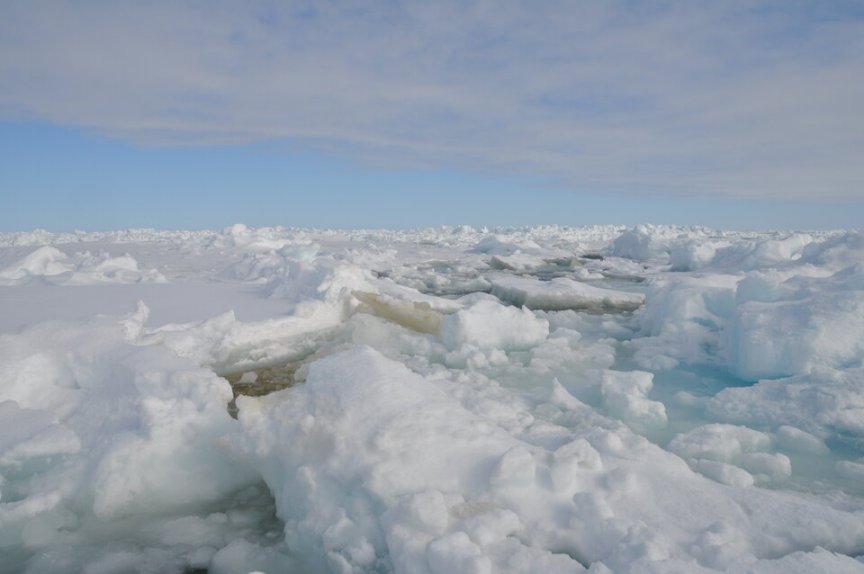
Snow-covered arctic sea ice
However, the ability to use satellite measurements to provide an overall picture of photosynthetically active radiation beneath the ice is an extremely useful tool to support other methods of monitoring the Arctic ecosystem.
“This unprecedented use of satellite data benefits our knowledge of the rapidly changing Arctic ecosystem,” Julien said. “Understanding the photosynthetically active radiation that penetrates sea ice will help broader research to understand what exactly is happening to life in the Arctic Ocean due to climate change.”
Given that snow is a key factor in determining how deeply sunlight penetrates ice, the CryoSat and ICESat-2 collaboration, known as Cryo2ice, should provide additional insights.
The two satellites will line up nearly simultaneously over the Arctic in the winter of 2024, and the combined measurements will give us the best estimate yet of the snow cover on top of the ice.
With the CryoSat radar and ICESat-2 lidar instruments working in tandem, we will gain insight into the future of ice altimetry. The Copernicus Polar Ice and Snow Topography Altimeter (CRISTAL) mission will use dual-frequency radar to accurately map snow depth on sea ice, continuing satellite records of polar ice into the 2030s.
“After 14 years, it is gratifying to see that CryoSat continues to find new applications,” says CryoSat mission manager Tommaso Parrinello. “The rapid changes occurring in the Arctic will have far-reaching consequences that will affect us all.
Preserving long-term satellite records is vital to our ability to understand them and navigate the future. I look forward to the results of the Cryo2ice collaboration in the coming months and years, and to the CRISTAL mission that will maintain the climate record beyond CryoSat.”
In 2021, an expedition off the icy north coast of Greenland discovered what appeared to be a previously uncharted island. It was small and gravelly, and was heralded as a contender for the title of the world’s northernmost known landmass. The discoverers named it Qeqertaq Avanarleq, which means “northernmost island” in Greenlandic. Over the past decade, several more small islands have been discovered north of Cape Morris Jesup, the northern tip of Greenland, only to disappear. Some scientists have suggested that they were debris from rocky shores carried by sea ice.
But when a team of Swiss and Danish surveyors traveled north to investigate the “ghost islands” phenomenon, they discovered something entirely different. In September 2022, they announced their findings: The elusive islands were actually large icebergs lying on the seabed. They likely came from a nearby glacier, covered in gravel by landslides.
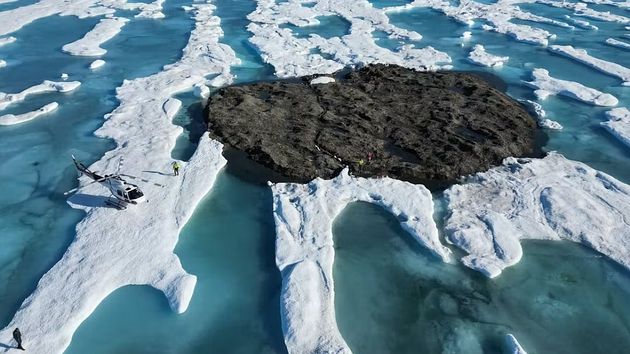
It was not the first time that explorers in the Arctic had changed maps of the region. As The Conversation reports, almost a century ago, in 1931, a pioneering airborne expedition in the airship Graf Zeppelin remade maps of large swathes of the Barents Sea. The five-day journey took the expedition north across the Barents Sea to 82°N, then hundreds of miles east before returning to the southwest. The high-latitude regions over which the Graf Zeppelin flew were incredibly remote. The polar expedition confirmed the existence of Franz Josef Land, but it also showed that the maps drawn by early explorers of the high Arctic were strikingly flawed. The expedition also discovered six new islands and changed the coastlines of many others, or erased them from maps altogether.
Climatologists and oceanographers have found evidence that the abnormally rapid rise in sea levels in some regions of the northwest Atlantic is linked to rising temperatures in deep waters flowing into the Atlantic from the Antarctic coast, TASS reported, citing the University of Miami press service.
The observations highlight that human activity is affecting even the most remote and inaccessible regions of the oceans. Anthropogenic factors have influenced the interaction between two regions of the Atlantic that are thousands of kilometers apart, and one of them is located at a depth of several kilometers.
The researchers came to this conclusion by analyzing data collected between 2000 and 2020 by deep-sea buoys installed on the bottom of the Atlantic Ocean in its tropical regions at a depth of several thousand meters. These systems track the movement of deep currents, which are part of the so-called Atlantic Meridional Circulation. This is what scientists call a huge closed system of currents that covers the entire Atlantic Ocean and plays a key role in the exchange of water between its surface and deep layers. In recent years, oceanographers and climatologists have begun to fear that the slowdown of this “conveyor belt” of currents as a result of global warming will lead to radical changes in the transfer of heat and water in the World Ocean.
The analysis found that the speed of the deep Atlantic Meridional Circulation has slowed by about 12% over the past two decades. This slowdown is due to the fact that rapidly rising temperatures in the Earth’s polar regions are preventing warm water off the coast of Antarctica from cooling and sinking to depths, from where these cold streams of liquid move toward the equator and the North Atlantic.
The weakening of deep-sea transport has caused the deep Atlantic to warm by a few thousandths of a degree Celsius, causing an abnormally rapid rise in sea level off the eastern coast of North America as a result of thermal expansion of the ocean. The subsequent weakening of cold Antarctic currents will further accelerate the warming of the deep Atlantic, making sea level rise off the coasts of the United States, Mexico, and the Caribbean even more visible.
Climatologists have found that the record reduction in sea ice off the coast of Antarctica, recorded in 2023, has led to virtually irreversible changes in the state of the ice cover of the entire Antarctic. These changes will have a significant impact on the state of the ecosystems of the southern polar region, TASS reports, citing the press service of the British Antarctic Survey (BAS).
Antarctic sea ice will not fully recover for another two decades. This long-term loss of ice will have profound effects on local and global weather patterns, as well as on the unique ecosystems of the Southern Ocean, including whale and penguin populations.
The scientists came to this conclusion as part of calculations with which they tried to reproduce the record-breaking retreat of glaciers in Antarctica that occurred last winter. As part of this, the ice cap of the South Pole has shrunk by about 2.5 million square kilometers compared with previous winters, which is comparable in area to several large European countries.
Such a strong and sudden reduction in the area of the Antarctic ice cover, which interrupted long-term trends of increasing area of Antarctic ice, forced scientists to study in detail all the circumstances associated with this climate record. To do this, the researchers used 18 different climate models of the Earth to analyze how various natural and anthropogenic climate factors affected the area of ice at the South Pole of the planet.
Calculations conducted by scientists indicated that last year’s reduction in sea ice area was an extremely unlikely event – its analogues could have occurred only once in 2.6 thousand years, taking into account all possible short-term and long-term climate fluctuations. For this reason, scientists believe that such a retreat of ice was associated with anthropogenic global warming, which increased the likelihood of such sharp reductions in ice area by about 4-5 times.
Moreover, the scientists’ calculations indicate that this event will lead to very long-term changes in the appearance of the Antarctic ice cover, since the areas of sea ice that disappeared in 2023 will not recover even after several decades. This could lead to radical changes in the state of the climate, weather, and ecosystems in the southern polar regions of the Earth, the researchers concluded.
Seawater flowing under Antarctica’s Thwaites Glacier and seeping into its crevices is helping to melt the massive ice cap, a team of scientists says. These sections of the glacier could be subject to “intense melting” from warm ocean water caused by climate change, which could lead to even faster sea level rise around the world.
“The problem is that we are underestimating the rate of glacier change, which could have devastating consequences for coastal communities around the world,” Christine Dow, a professor at the University of Waterloo in Canada and co-author of the study, said in a press release.
However, the researchers say more work is needed to fully understand the impact of the warm water beneath the ice sheet.
At about 80 miles across, Thwaites is the widest glacier in the world and about the size of Florida. It has been nicknamed the “Doomsday Glacier” because of the catastrophic impact its melting would have on global sea level rise.
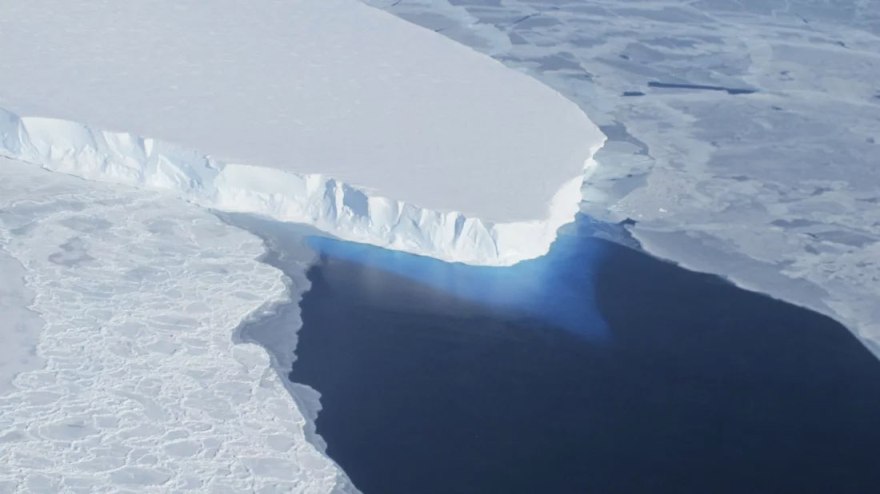
Thwaites Glacier loses about 50 billion tons of ice each year, accounting for about 4 percent of the world’s sea level rise, according to the International Thwaites Glacier Collaboration. One estimate suggests that the complete loss of Thwaites Glacier could cause average sea levels to rise by more than two feet, and even more in some parts of the United States.
In a study published Monday in the journal Proceedings of the National Academy of Sciences, a team of glaciologists used radar data collected between March and June last year by Finland’s commercial satellite program ICEYE to gain a better understanding of what’s happening beneath the glacier’s surface.
They found that seawater flows in and out of the glacier with the tides, mixing with fresh water, but some of this warm ocean water also moves deep beneath the ice sheet, passing “through natural channels” or collecting “in cavities” and becoming trapped.
“There are places where the water is almost under the pressure of the ice above, so it only takes a little bit more pressure to push the ice up,” said Eric Rignot, a professor of Earth system sciences at the University of California, Irvine, and lead author of the study. “Then the water is compressed enough to lift a column of ice more than half a mile thick.”
Salty seawater near the South Pole has a lower freezing point (28 degrees Fahrenheit) than fresh water, which may further contribute to the melting of glaciers.
Dow suggested that additional ice sheet modeling could help scientists better understand what’s happening beneath these large glaciers and develop a more accurate timeline of expected sea level rise around the world.
A study has found that giant slush zones pose a new threat to Antarctic ice. The wetlands could cause more ice shelves to crack or collapse, leading to faster sea level rise.
A detailed new analysis of NASA satellite images shows that Antarctica’s ice shelves hold far more meltwater than previously thought, much of it trapped in vast areas of slush that have not been carefully mapped. The new information will help determine how vulnerable the shelves are to cracking and disintegration, according to an international team of scientists who published their findings in Nature Geoscience this week.
Human-caused climate warming means more meltwater is forming on the surface of ice shelves, which are floating extensions of Antarctica’s giant glaciers. When ice shelves crumble and break up, it can speed up the flow of land ice into the sea and increase the rate of sea level rise.
Earlier this week, another study published in the same journal also demonstrated the growing vulnerability of Antarctic ice shelves to melting from below, with the results suggesting that ocean warming is likely to lead to “runaway melting.”
However, until now it has been difficult to accurately map the slush zones because they are hard to distinguish from surrounding areas, says lead author Rebecca Dell, a glaciologist at the University of Cambridge’s Scott Polar Research Institute.
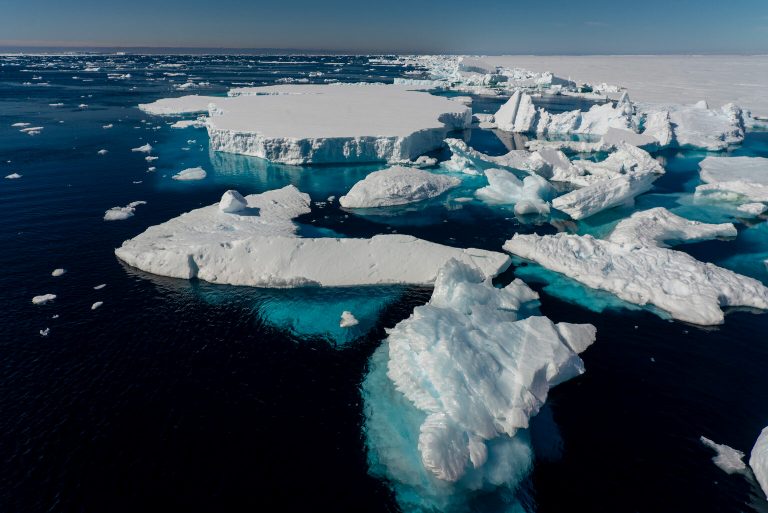
The collapse of the Larsen B ice shelf along the Antarctic Peninsula stunned scientists who study ice and helped bolster confidence that global warming is likely to trigger more such events. Subsequent research has suggested that another 0.5 degree Celsius rise in Earth’s average temperature could push Antarctic ice shelves beyond the point of no return.
The new study suggests there may be more water on the surface of ice shelves than previously thought based on studies that looked only at lakes, she said.
The newly mapped slush has other implications for the future of ice shelves, Dell added. Because slush and lakes are less white than snow or ice, they absorb more heat from the sun, causing more snow to melt. This extra melting is not currently accounted for in climate models, which could lead to underestimates in ice sheet melting and ice shelf stability projections. Some researchers are also now beginning to study meltwater on the surface of land-based ice sheets and glaciers, in addition to floating ice shelves.
“The term that’s being thrown around a lot now is the ‘Greenlandization of Antarctica,'” she said. “In Greenland, we see a lot more meltwater above the ice sheets, and we know that when that meltwater drains to the bottom, it can change the speed of the Greenland ice sheet as it moves out to sea.”
Antarctica’s land-based ice sheets are currently not melting as much as floating ice shelves or Greenland, she said, but that will likely change with further warming.
Even a small increase in ocean temperatures could lead to a sudden acceleration in the melting of glaciers in Antarctica, write British scientists Alexander Bradley and Ian Hewitt in an article for the scientific journal Nature Geoscience.
“We found that rising ocean temperatures could lead to a tipping point, after which ocean water would flow unrestrained beneath the ice sheet through unstoppable melting,” the paper says.
Scientists explain that warming seawater, which gradually melts the glacier and penetrates under the shield, will sooner or later lead to very rapid flooding of the ice voids and a sharp increase in the rate of melting. But it is extremely difficult to predict the onset of such a “turning point” for the glacier, they note.




